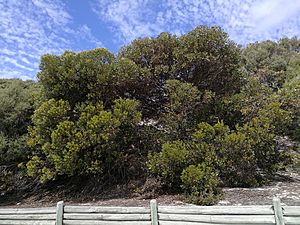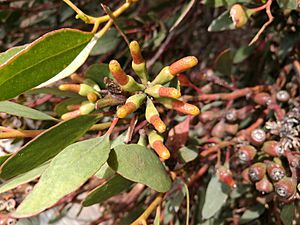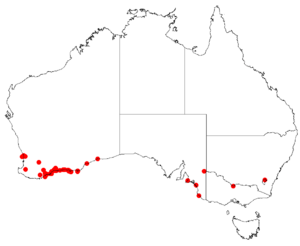Coastal moort facts for kids
Quick facts for kids Coastal moort |
|
|---|---|
 |
|
| Eucalyptus utilis (lower, green trees) | |
 |
|
| Eucalyptus utilis (buds and fruit) | |
| Scientific classification | |
| Genus: |
Eucalyptus
|
| Species: |
utilis
|
 |
|
| Occurrence data from AVH | |
| Synonyms | |
|
Eucalyptus platypus var. heterophylla auct. non Blakely: Chippend. |
|
The Coastal Moort (scientific name: Eucalyptus utilis) is a special type of tree or large shrub. It is also known as the Coastal Mort. This plant grows naturally in the southern parts of Western Australia.
It can be a "mallet" or a "mallee". A mallet is a single-stemmed tree, while a mallee is a shrub with many stems growing from the ground. The Coastal Moort has smooth bark, leaves shaped like eggs or spears, and creamy white flowers. Its fruit looks like a cone.
Contents
What it Looks Like
The Coastal Moort is usually a mallet or a mallee. It can grow from about 1.5 to 15 meters (5 to 49 feet) tall. It often has branches that spread out wide.
It has a short trunk with smooth grey bark. This bark peels off in strips, showing pale brown bark underneath. The leafy part of the plant (the crown) is usually close to the ground and very thick.
Leaves
Young Coastal Moort plants have green or greyish leaves. These leaves are shaped like eggs. They are about 2 to 8 centimeters (0.8 to 3.1 inches) long. They are also about 1.5 to 3.5 centimeters (0.6 to 1.4 inches) wide.
Adult leaves are thick and shiny olive green on both sides. They are shaped like eggs or spears. These leaves are about 4.5 to 8 centimeters (1.8 to 3.1 inches) long. They are also about 1 to 4 centimeters (0.4 to 1.6 inches) wide. Each leaf has a stem (called a petiole) that is about 0.8 to 2 centimeters (0.3 to 0.8 inches) long.
Flowers and Fruit
The flower buds grow in groups of seven. They are found where the leaves meet the stem. These groups of buds grow on a flat, unbranched stalk (called a peduncle). This stalk is about 1.3 to 3.3 centimeters (0.5 to 1.3 inches) long. Some buds sit directly on the stalk, while others have very short stems (pedicels) up to 0.5 centimeters (0.2 inches) long.
When the buds are ready, they are long and egg-shaped. They are about 1.2 to 2.8 centimeters (0.5 to 1.1 inches) long. They are also about 0.4 to 0.7 centimeters (0.2 to 0.3 inches) wide. Each bud has a horn-shaped cap (called an operculum). This cap can be up to 2.5 times longer than the base of the flower.
Coastal Moort flowers bloom from September to January. The flowers are a creamy white color. After flowering, the plant produces woody fruit. These fruits are shaped like cones or small barrels. They are about 0.8 to 1.3 centimeters (0.3 to 0.5 inches) long. They are also about 0.7 to 1 centimeter (0.3 to 0.4 inches) wide. The fruit grows on stalks that point downwards or spread out. Inside the fruit are oval, black or brown seeds. These seeds are about 0.7 to 2 centimeters (0.3 to 0.8 inches) long.
How it was Named
The Coastal Moort, Eucalyptus utilis, was officially described in 2002. Two botanists, Ian Brooker and Stephen Hopper, gave it its scientific name. They wrote about it in a science magazine called Nuytsia. The plant specimens they studied were collected by Charles Austin Gardner in 1964. He found them near a town called Hopetoun.
The second part of its scientific name, utilis, comes from a Latin word. Utilis means "useful". This name was chosen because the tree is very helpful. People use it for planting in streets and on farms.
Where it Grows
The Coastal Moort is found along the western and southern coasts of Western Australia. You can find it as far north as Perth. Most of these plants grow between Fitzgerald River National Park and Esperance in the east. Some scattered groups are found even further east.
It also grows on islands in the Recherche Archipelago. These islands include Middle Island and Mondrain Island. The Coastal Moort can live in many different places. It grows on sand dunes, near granite hills, and close to swamps and rivers. It can grow in sandy or clay soils. It is native to some areas and has spread to others.
Conservation Status
The government of Western Australia, through its Department of Parks and Wildlife, says that this eucalypt is "not threatened". This means it is not currently at risk of disappearing.
Uses for People
The Coastal Moort is a popular plant for growing. You can buy it from nurseries. People often use it for decoration in gardens. It is also good for creating windbreaks and shelter belts. These help protect other plants or animals from strong winds.
This plant is tough! It can handle dry weather (drought tolerant). It can also survive some frost. It grows well in sandy soils that are not very rich and can be alkaline (the opposite of acidic). It can even handle a little bit of salt.
The Coastal Moort produces a lot of pollen and nectar. This is great for bees and other insects. It also provides good homes for birds and insects.

